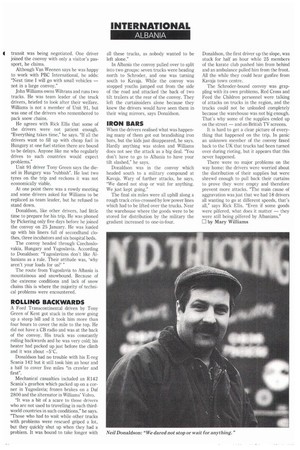INTERNATIONAL
Page 36

If you've noticed an error in this article please click here to report it so we can fix it.
ALBANIA
1 transit was being negotiated. One driver joined the convoy with only a visitor's passport, he claims.
Although Van Weenen says he was happy to work with PBC International, he adds: "Next time I will go with small vehicles — not in a large convoy."
John Williams owns Wiltrans and runs two trucks. He was team leader of the truck drivers, briefed to look after their welfare, Williams is not a member of Unit 91, but was one of the drivers who remembered to pack snow chains.
He agrees with Rick Ellis that some of the drivers were not patient enough. "Everything takes time," he says. "If all the drivers want to fill up with cheap fuel in Hungary at one fuel station there are bound to be delays. Anyone like me who regularly drives to such countries would expect problems."
Unit 91 driver Tony Green says the diesel in Hungary was "rubbish". He lost two tyres on the trip and reckons it was not economically viable.
At one point there was a rowdy meeting and some drivers asked for Williams to be replaced as team leader, but he refused to stand down.
Donaldson, like other drivers, had little time to prepare for his trip. He was phoned by Pickering only five days before he joined the convoy on 25 January. He was loaded up with bin liners full of secondhand clothes, three incubators and six hospital beds, The convoy headed through Czechoslovakia, Hungary and Yugoslavia. According to Donaldson: "Yugoslavians don't like Albanians as a rule. Their attitude was, 'why aren't your loads for us?' " The route from Yugoslavia to Albania is mountainous and snowbound. Because of the extreme conditions and lack of snow chains this is where the majority of technical problems were encountered.
A Ford Transcontinental driven by Tony Green of Kent got stuck in the snow going up a steep hill and it took him more than four hours to cover the mile to the top. He did not have a CB radio and was at the back of the convoy. His truck was constantly rolling backwards and he was very cold; his heater had packed up just before the climb and it was about –5°C.
Donaldson had no trouble with his E-reg Scania 142 but it still took him an hour and a half to cover five miles "in crawler and first".
Mechanical casualties included an R142 Scania's gearbox which packed up on a corner in Yugoslavia; frozen brakes on a Daf 2800 and the alternator in Williams' Volvo.
"It was a bit of a scare to those drivers who are not used to travelling in such thirdworld countries in such conditions," he says. "Those who had to wait while other trucks with problems were rescued griped a lot, but they quickly shut up when they had a problem. It was bound to take longer with all these trucks, as nobody wanted to be left alone."
In Albania the convoy pulled over to split into two groups: seven trucks were heading north to Schroder, and one was turning south to Kavaja. While the convoy was stopped youths jumped out from the side of the road and attacked the back of two tilt trailers at the rear of the convoy. They left the curtainsiders alone because they knew the drivers would have seen them in their wing mirrors, says Donaldson.
When the drivers realised what was happening many of them got out brandishing iron bars, but the kids just disappeared, he says. Hardly anything was stolen and Williams does not see the attack as a big deal. "You don't have to go to Albania to have your tilt slashed," he says.
Donaldson was in the convoy which headed south to a military compound at Kavaja. Wary of further attacks, he says, "We dared not stop or wait for anything. We just kept going."
The final six miles were all uphill along a rough track criss-crossed by low power lines which had to be lifted over the trucks. Near the warehouse where the goods were to be stored for distribution by the military the gradient increased to one-in-four.
Donaldson, the first driver up the slope, was stuck for half an hour while 25 members of the karate club pushed him from behind and an ambulance pulled him from the front. All the while they could hear gunfire from Kavaja town centre.
The Schroder-bound convoy was grappling with its own problems. Red Cross and Feed the Children personnel were talking of attacks on trucks in the region, and the trucks could not be unloaded completely because the warehouse was not big enough, That's why some of the supplies ended up on the street — and on British TV screens.
It is hard to get a clear picture of everything that happened on the trip. In panic an unknown member of the convoy faxed back to the UK that trucks had been turned over during rioting, but it appears that this never happened.
There were no major problems on the way home: the drivers were worried about the distribution of their supplies but were shrewd enough to pull back their curtains to prove they were empty and therefore prevent more attacks. "The main cause of aggravation was just that we had 18 drivers all wanting to go at different speeds, that's all," says Rick Ellis. "Even if some goods were pilfered, what does it matter — they were still being pilfered by Albanians."
El by Mary Williams




















































































